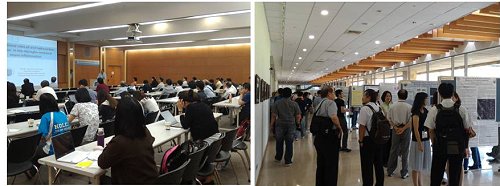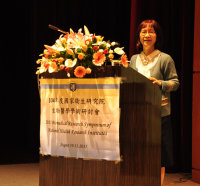NHRI Communications

會議報導
104年度國家衛生研究院生物醫學學術研討會紀實
Report on 2015 Biomedical Research Symposium of National Health Research Institutes
 104年度國家衛生研究院生物醫學學術研討會(2015 Biomedical Research Symposium of NHRI)已於8月10日至11日假本院會議中心召開。此次會議除有整合性醫藥衛生科技研究計畫(以下簡稱整合性計畫)研究人員參與外,亦邀請院外計畫學術審查之國內、外專家50餘位共同與會,另開放本院研究人員及國內各機構研究人員約350位報名與會,總計人數約400餘人次,可謂盛況空前,充分達到學術交流之目的。
104年度國家衛生研究院生物醫學學術研討會(2015 Biomedical Research Symposium of NHRI)已於8月10日至11日假本院會議中心召開。此次會議除有整合性醫藥衛生科技研究計畫(以下簡稱整合性計畫)研究人員參與外,亦邀請院外計畫學術審查之國內、外專家50餘位共同與會,另開放本院研究人員及國內各機構研究人員約350位報名與會,總計人數約400餘人次,可謂盛況空前,充分達到學術交流之目的。此次會議首日上午由本院龔行健院長主持開幕,隨後邀請行政院科技部錢宗良政務次長以「科技創新作為註1」為題發表演說;次日上午則邀請國立台灣大學附設醫院肝炎研究中心張美惠教授以「Molecular Carcinogenesis and Prevention of Liver Cancer - A Study from Children to Adults註2」為題發表演說。
除前述特別演講外,另規劃「Biomedical Science」、「Population Health Research」、「Cancer Research」、「Medical Engineering」、「Molecular Genetics and Medicine」及「Neural Science」等6項專題演講,由執行成果優良之整合性計畫主持人、本院研究人員或年輕研究學者及國內專家共24位,於2個會場同步進行演講,分享其研究成果與經驗,促進學術交流及研究合作。
囿於演講場次有限,本次會議另安排兩個壁報時段(Poster Session),由整合性計畫主持人及本院研究人員張貼壁報展示研究成果(共計發表135篇壁報論文),並分組安排壁報論文討論會議(Poster Discussion),由各組會議主持人邀請部分壁報展示之研究人員簡短報告分享研究成果,以促進壁報發表者、計畫主持人、所有分組與會人員及學術審查委員間之討論與互動,除有助於委員瞭解計畫執行成效,亦能協助解決研究過程可能遭遇之困難。
在2天的學術活動中,藉由演講、壁報論文展示及分組討論會議等安排,引發熱烈討論及腦力激盪,使與會人員獲益良多,且因交流互動增加,促使未來合作或團隊研究形成之可能,為國人之醫藥研究發展水準厚植潛力。

註1:錢宗良政務次長特別演講摘要(演講內容請見電子報第618期「影音節目」)
講題:科技創新作為
成為國家科技發展的觸媒,塑造良好研發環境,協助政府部會與產業充分發揮研發資源的效益,提升國家競爭力,促進國家經濟發展與社會和諧。
物盡其用:在政策上釐清部會間科技研發的優先次序,在技術上配置最有效的方法,發揮有限預算的最大效益。(錢花在刀口上)
人盡其才:重點支持學術界人才從事國際尖端研究,並進一步發揮學界人才寶庫對國家產業、本土社會之責任與效益(以天下興亡為己任)。
施政重點:
- 鼓勵研究卓越與創新
- 加強產學鏈結
- 培養務實研究人才,縮減產學落差
- 調和科技與人文,深化科技在文化創作與普及之應用
- 成立學術研究諮議會
- 成立產學推動諮議會
- 促進產學交流合作,提升學生的實用技能,縮減產學落差
- 構思文化藝術相關合作課題
- 將進一步鼓勵尖端研究、貼近產業需求、縮短產學落差及深化人文社會研究
- 加強與各部會橫向溝通與協調,共同落實我國總統「創新強國」的理念
註2:張美惠教授特別演講摘要(演講內容請見電子報第619期「影音節目」)
 Title : Molecular Carcinogenesis and Prevention of Liver Cancer - A Study from Children to Adults
Title : Molecular Carcinogenesis and Prevention of Liver Cancer - A Study from Children to AdultsLiver cancer is the second common cause of cancer death globally. Effective strategies of prevention and therapy for liver cancer are very important. Chronic hepatitis B virus (HBV) is closely related to chronic hepatitis, liver cirrhosis, and hepatocellular carcinoma (HCC). The world first universal hepatitis B immunization program was launched in Taiwan since July 1984. We have demonstrated the successful liver cancer preventive effect of universal HBV immunization in children and adolescents. Since the levels of protective antibody decline with time, whether adult HCC can be prevented by infantile hepatitis B virus (HBV) immunization is an open question. We continuously investigated the epidemiologic changes of HCC incidence from before the HBV vaccination program to 27 years after the program. We found that the incidence rates of HCC were significantly reduced in both children aged 6 to 19 and young adults.
In spite of the great success of the HBV immunization program in preventing HCC in Taiwan, still there are problems to be overcome for better control of hepatitis B and liver cancer. Vaccine failure is the key problem to be solved. Mother-to-infant transmission from highly viremic mothers is the main cause of vaccine failure. Effective strategies to block mother-to-infant transmission of HBV, such as first dose of HBV vaccine and hepatitis B immunoglobulin within 24 hours after birth, and antiviral therapy during the last trimester of pregnancy, is very important to achieve better hepatitis B and liver cancer prevention.
Male predominance of human HCC occurs in all ages, particularly among children aged 6-9 years before puberty. It implicates a role of other male-specific factors, such as the Y-chromosome-encoded oncogenes, rather than the androgenic effect. The discovery of oncogenic activation of RNA-binding motif on Y chromosome (RBMY), which is not expressed in normal hepatocytes but present in male HCC tissues, shed light on the resolution of this issue. Our study demonstrated that RBMY is a novel oncofetal protein. During liver development, the Ser/Thr phosphorylated RBMY is expressed in the cytoplasm of human and rodent fetal livers. It is then silenced in mature hepatocytes and restricted to scarce expression in the bile ductules. Its key role in attenuating GSK3βactivity leads to aberrant activation of Wnt/β-catenin signaling and facilitates malignant hepatic stemness. Upon tumor initiation and progression, a noteworthy increase of RBMY is observed in rat tumor-like hepato-spheres and the cancer stem cells (CSCs) of human HCC tissues, and correlates significantly to a poor prognosis and decreased survival rate in HCC patients.
In addition to prevention, effective treatment is also very important to control liver cancer. However, current drug therapy against liver cancer is still unsatisfactory. Understanding the oncogenic mechanisms of liver cancer may facilitate the development of better therapies to cure liver cancer.
《文/圖:學術發展處蕭振祥》